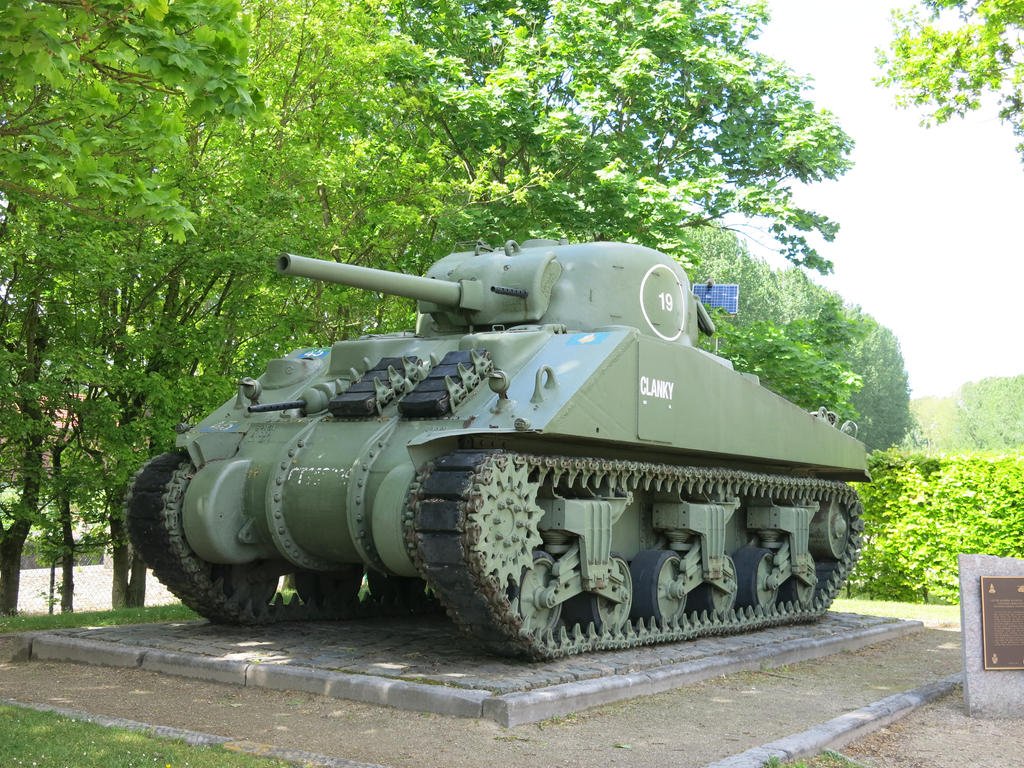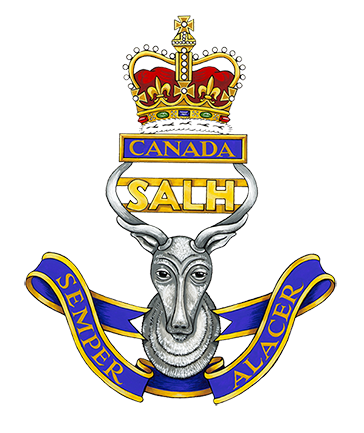
The beloved, and begrudged Horses of the Regiment.
-

Vehicle Type: M-3 Half-track, Manufacturer: White Motor Company, Years in Service: 1944-1945
The Regiment's White Motor Company, American-made model M3 Armoured Command Vehicle was “procured”
by General Worthington from an American army base in England.
The South Alberta Regiment retrofitted it for use as a command vehicle. They equipped the rear with several radios and set up the space behind the front seats as a map and workroom. Here, Lieutenant Colonel Gordon Wotherspoon processed intelligence, received orders, and planned battle strategies for the duration of the war.
At the war’s end, several SAR officers purchased the halftrack from a surplus dealer and arranged to have it shipped back to Canada. The vehicle was used in exercises for several years and carried the South Alberta Light Horse Regiment’s guidon party during the parading of the unit’s colours in Medicine Hat in 1967.
In January 2004, a team of SALH members from B Squadron in Edmonton began restoring “Old Reliable” to fully operable condition. General Hillier catches a ride in Old Reliable at the Cavalry Stampede 2010
Effectively restored to operational condition in time for the 100th anniversary of the regiment in 2005, the restoration took approximately 8,000 hours and the cost $62,000.00. Funding was graciously provided by the South Alberta Light Horse Regiment Foundation.
-

Vehicle Type: Lynx, Manufacturer: Ford Canada Years in Service: 1943-1964
The Lynx scout car was designed in 1941 and was based on the Daimler Scout Car (Dingo) which was also supplied to Canadian Forces. Production began in 1942 and by 1945 3,255 Lynxes were produced by Ford at Windsor, Ontario. The hulls were fabricated by the International Harvester Co., Hamilton, Ontario.
-

Vehicle Type: T17E1 Staghound, Manufacturer: Chevrolet, Years in Service: 1942-1964
The T17E1 was armed with a 37 mm M6 gun, a coaxial .30 cal Browning 1919A4 machine gun and a 2-inch smoke mortar in a rotating turret. In the hull was mounted a .30 cal Browning 1919A4 machine gun. Some T17E1 had an additional .30 Browning 1919A4 cal machine gun for anti-aircraft defense. The turret had power traverse and featured a turret basket (which limited the amount of internal crew storage). The 37 mm gun was gyroscopically stabilized.
This variant had a crew of 5, commander, loader, gunner, and hull machine gunner. This variant saw combat with the British, Free Polish, Canadian, New Zealand, Indian, and Belgian armies in Italy, Greece and Northwest Europe.
Following WW2, the Staghound saw service in Canada and was employed by the 19th Alberta Dragoons to patrol the Alaska Highway.
-

Vehicle Type: The Ferret Scout Car, Manufacturer: Daimler, Years in Service: 1954-1981
The Ferret armoured car, also commonly called the Ferret Scout car, was a British armoured fighting vehicle designed and built for reconnaissance purposes. The Ferret was produced between 1952 and 1971 by the UK company, Daimler. It was widely adopted by regiments in the British Army as well as Commonwealth countries throughout the period.
The Ferret was developed in 1949 as a result of the British Army's need to obtain a replacement model for its WW2 light armoured vehicles. Due to the success of their Reconnaissance Scout Car, the "Dingo", Daimler was employed to design and manufacture the Ferret.
The Ferret shared many similar design features with the Dingo and Canadian Ford Lynx, but featured a larger fighting compartment and an optional small machine gun turret. It was built from an all-welded monocoque steel body, making the vehicle lower but also making the drive extremely noisy inside as all the running gear was within the enclosed body with the crew. Four wheel drive was incorporated together with "Run flat" tires (which kept their shape even if punctured in battle, thus enabling a vehicle to drive to safety.) The turret, though not fitted to all models, carried a single machine gun. Six grenade launchers fitted to the hull (three on each side) could carry smoke grenades.
Canada purchased 124 Ferret Mark I Scout Cars in 1954, and used them until 1981.
-

Vehicle Type: M113 C&R Lynx, Manufacturer: FMC Corp., Years in Service: 1968-1993
The Lynx was a command and reconnaissance vehicle built as a private venture in 1963 by FMC Corp, the manufacturer of the M113 armoured personnel carrier. The Lynx used M113A1 components, including aluminum armour, but with only four road wheels on each side and engine in the rear instead of the front.
The Lynx was amphibiuos, propelled in the water by its tracks. Before swimming, a trim vane was erected at front, bilge pumps started, and covers mounted on the air intake and exhaust. In practice, crews would close hatches and ford shallow streams at high speed.
The Canadian Forces accepted 174 Lynx vehicles in 1968 which replaced the Ferret armoured car. Lynxes were issued to the reconnaissance squadron of Canada's armoured regiments. The squadron consisted of three troops, each equipped with seven Lynxes—three two-vehicle patrols plus the troop leader's vehicle. Nine Lynxes also equipped the reconnaissance platoon of an infantry battalion's combat support company. Many reservists trained on the Lynx as part of their basic reconnaissance training.
In the Canadian Lynx, the crew commander's cupola is located middle-right, observer's hatch rear-left. The commander operates the manually traversed M26 heavy machine gun cupola from inside the vehicle, but reloads it with hatch open. The rear-facing observer operates the radio and fires the pintle-mounted 7.62mm machine gun.
The Canadian Lynx was withdrawn from service in 1993, and replaced in the regular Force by 203 Coyote eight-wheeled reconnaissance vehicles in 1996.
-

Vehicle Type: AVGP Cougar, Manufacturer: General Motors Diesel Division, Years in Service: 1976 - 2005
The Armored Vehicle General Purpose (AVGP) fleet is comprised of three variants: the Cougar, the Grizzly, and the Husky. The AVGP fleet entered service in 1976. A total of 195 Cougars were originally procured to equip Regular and Reserve armored units. Following the acquisition of the Coyote as a part of the 1999 Army Equipment Rationalization Plan, the Cougar fleet was reduced to 100 vehicles – to be exclusively employed by Reserve armored units. The Cougar was retired from service in 2005 with the transition of all Reserve Armoured Regiments to reconnaissance.
Armament:
76-mm L23A1 gun, [fires HESH, Smoke BE (base ejected), and Canister rounds]
7.62 mm machine gun (C6)
66-mm smoke grenade launchers (2 clusters of 4 launchers)
-

Vehicle Type: Iltis, Manufacturer: Volkswagen/Bombardier, Years in Service: 1985-2005
The Iltis was the Canadian replacement for the M151A2 and was built in Canada by Bombadier. Iltis is German for "ferret". It isequipped with a 1714cc four cylinder OHC engine which develops 75 bhp @ 5,000 rpm. The Iltis has a manual transmission with 5 speeds however, only gears 1-4 are used for normal operation. There is a movable sleeve on the the gear shift to access the fifth gear which is, in reality, not a fifth gear but a super low first gear.
The Iltis also has selectable 4wd. There is a small lever on the floor between the driver's and passenger's seat located next to the passenger's seat that shifts between 4wd and 2wd. This switching is purely mechanical. When you put the Iltis into 2wd it goes into rear-wheel-drive. Engaging the 4wd lever will engage the front wheels.
Between the driver's and passenger's seat located next to the driver's seat is another small lever which switches the differential lock in and out. The diff lock is on the rear wheels. This switching is purely mechanical. Diff lock is normally left in the out position. The super low first, which is labelled "G" on the shifter, is only available 4wd. The Iltis was used in the South Alberta Light Horse by both A and B Squadron between 1985 and 2005.
-

Vehicle Type: LUVW "G-Wagon" Recce Variant, Manufacturer: Mercedes Benz, Years in Service: 2005-Present
The LUVW “G Wagon” is a light utility Vehicle used by The SALH units as a tactical transport and reconnaissance vehicle. Its various other roles in the field consist of of command and control, liaison, reconnaissance and military police.
The G Wagon - Light Utility Vehicle Wheeled (LUVW) is powered by a 2.7-litre, 5-cylinder, turbo-charged diesel engine. It can be outfitted with a tailored armour protection systems kit.
The Recce variant is armed with one 7.62 mm machine gun (C6) -

Tactical Armored Patrol Vehicle (TAPV), Manufacturer: Textron, Years in Service: 2018-Present
The TAPV is a wheeled combat vehicle designed to conduct reconnaissance and surveillance, security, command and control, and armoured transport of personnel and equipment.
This vehicle was acquired with the plan to replace the reconnaissance vehicles LAV II.
Armament;
6x MBGDs1x 40MM grenade machine gun (C16)
1x 7.62 MM machine gun (C6 Flex)
